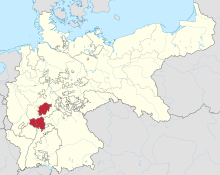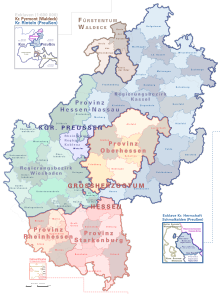This article needs additional citations for verification .(January 2015) |




This article is about the history of Hesse. Hesse is a state in Germany.
This article needs additional citations for verification .(January 2015) |




This article is about the history of Hesse. Hesse is a state in Germany.
In the Paleolithic Era, the Central Hessian region around Wetzlar was settled. Extensive excavations along the Lahn in Wetzlar-Dalheim recently uncovered a 7000-year-old settlement from the Linear Pottery culture. Bell Beaker shards found in Rüsselsheim, Offenbach, Griesheim and Wiesbaden suggest settlement in southern Hesse 4,500 years ago.
In 1568 with the death of Landgrave Philip I, the Landgraviate of Hesse (German : Landgrafschaft Hessen), a German Principality of the Holy Roman Empire, was divided among his sons. With the extinction of the Hesse-Marburg and Hesse-Rheinfels lines by 1604, Hesse-Darmstadt, along with Hesse-Kassel, became one of the two Hessian states. While Hesse-Kassel converted to Calvinism and became one of the most zealous exponents of the Protestant cause in the Thirty Years' War, Landgrave George II remained a strict Lutheran and maintained a close alliance with Saxony, which led to a pro-Habsburg policy after 1642.
Hesse-Darmstadt gained a great deal of territory from the secularization and modifications authorized by the Reichsdeputationshauptschluss of 1803. The acquisition of the Duchy of Westphalia, formerly owned by the Archbishop of Cologne, was significant, as were the acquisition of territories from the Archbishop of Mainz and the Bishop of Worms. In 1806, upon the dissolution of the Reich and the dispossession of his cousin, the Elector of Hesse-Kassel, the Landgrave took the title of Grand Duke of Hesse.
At the Congress of Vienna, the Grand Duke was forced to cede Westphalia to Prussia. In exchange for this he received a piece of territory from the left bank of the Rhine, including the important federal fortress at Mainz. The Grand Duchy changed its name to the Grand Duchy of Hesse and by Rhine in 1816.
In 1867, the northern half of the Grand Duchy (Upper Hesse) became a part of the North German Confederation, while the half of the Grand Duchy south of the Main (Starkenburg and Rhenish Hesse) remained outside. In 1871, it became a constituent state of the German Empire. The last Grand Duke, Ernst Ludwig (a grandson of Queen Victoria and brother to Empress Alexandra of Russia), was forced from his throne at the end of World War I. The state was then renamed the Volksstaat Hessen (People's State of Hesse).
The majority of the state combined with Frankfurt am Main, the Waldeck area (Rhine-Province) and the old Prussian province of Hesse-Nassau to form the new state of Hesse following the Second World War. Excepted was the Montabaur district from Hessen-Nassau and that part of Hessen-Darmstadt on the left bank of the Rhine (Rhenish Hesse) became part of the Rhineland-Palatinate state. (Bad) Wimpfen — an exclave of Hessen-Darmstadt — became part of Baden-Württemberg, district of Sinsheim.
From the early years of the Reformation, the House of Hesse was predominately Protestant. Landgraves Philip I, William V, and Maurice married descendants of King George of Bohemia; from William VI onwards, mothers of the heads of Hesse-Kassel were always descended from William the Silent, the leader of the Dutch to independence on the basis of Calvinism.
The Landgraviate of Hesse-Kassel expanded in 1604 when Maurice, Landgrave of Hesse-Kassel inherited the Landgraviate of Hesse-Marburg from his childless uncle, Louis IV, Landgrave of Hesse-Marburg (1537–1604).
During the Thirty Years' War, Calvinist Hesse-Kassel proved to be Sweden's most loyal German ally. Landgrave William V and, after his death in 1637, his widow Amelia of Hanau, a granddaughter of William the Silent, as regent supported the Protestant cause and the French and Swedes throughout the war and maintained an army, garrisoning many strongholds, while Hesse-Kassel itself was occupied by Imperial troops.
William V was succeeded by Landgraves William VI and William VII. Under King Frederick I of Sweden, Hesse-Kassel was in personal union with Sweden from 1730–51. But in fact the King's younger brother, Prince William, ruled in Kassel as Regent until he succeeded his brother, reigning as William VIII until 1760.
Although it was a fairly widespread practice at the time to rent out troops to other princes, it was the Landgraves of Hesse-Kassel who became infamous for hiring out contingents of their army as mercenaries during the 17th and 18th centuries. Hesse-Kassel maintained 7% of its entire population under arms throughout the eighteenth century. This force served as a source of mercenaries for other European states. [1] Frederick II, notably, hired out so many troops to his nephew King George III of Great Britain for use in the American War of Independence, that "Hessian" has become a common term among Americans and historians for all German soldiers deployed by the British in the War. One of these regiments that saw service in America was the Musketeer Regiment Prinz Carl.
During the 17th century, the landgraviate was internally divided for dynastic purposes, without allodial rights, into:
These were reunited with the Landgraviate of Hesse-Kassel when each particular branch died out without issue.
Following the reorganization of the German states during the German mediatization of 1803, the Landgraviate of Hesse-Kassel was raised to the Electorate of Hesse and Landgrave William IX was elevated to Imperial Elector, taking the title William I, Elector of Hesse. The principality thus became known as Kurhessen, although it is still usually referred to as Hesse-Kassel.
In 1806, William I was dispossessed by Napoleon Bonaparte for his support of the Kingdom of Prussia. Kassel became the capital of a new Kingdom of Westphalia with Napoleon's brother Jérôme Bonaparte as king. The elector was restored following Napoleon's defeat in 1813, and although the Holy Roman Empire was now defunct, William retained his title of Elector, as it gave him pre-eminence over his cousin, the Grand Duke of Hesse. From 1813 onwards, the Electorate of Hesse was an independent country and, after 1815, a member of the German Confederation.
William's grandson, Elector Frederick William, sided with the Austrian Empire in the Austro-Prussian War. Following the Prussian victory his lands were annexed by Prussia in 1866. Along with the annexed Duchy of Nassau and Free City of Frankfurt, Hesse-Kassel became part of the new Province of Hesse-Nassau of the Kingdom of Prussia.
In 1918, Hesse-Nassau became part of the Free State of Prussia until 1944. From 1944–45 as part of Nazi Germany, it was divided into the Prussian provinces of Kurhessen and Nassau. From 1945–46, it was renamed Greater Hesse (German : Großhessen) and was part of the US occupation zone in Germany. From 1946 onwards, it was reorganized into the State of Hesse, a federal state of West Germany.
In 1918, Prince Frederick Charles of Hesse, younger brother of the head of the house and a brother-in-law of Emperor William II, was elected by the pro-German Finnish government to be King of Finland, but he never reigned.
In 1968, the head of the House of Hesse-Kassel became the head of the entire House of Hesse due to the extinction of the House of Hesse-Darmstadt.

Hesse or Hessia, officially the State of Hesse, is a state in Germany. Its capital city is Wiesbaden, and the largest urban area is Frankfurt, which is also the country's principal financial centre. Two other major historic cities are Darmstadt and Kassel. With an area of 21,114.73 square kilometers and a population of over six million, it ranks seventh and fifth, respectively, among the sixteen German states. Frankfurt Rhine-Main, Germany's second-largest metropolitan area, is mainly located in Hesse.

The Landgraviate of Hesse-Kassel, spelled Hesse-Cassel during its entire existence, was a state of the Holy Roman Empire. The state was created in 1567 when the Landgraviate of Hesse was divided upon the death of Philip I, Landgrave of Hesse. His eldest son William IV inherited the northern half of the Landgraviate and the capital of Kassel. The other sons received the Landgraviates of Hesse-Marburg, Hesse-Rheinfels and Hesse-Darmstadt.

The House of Hesse is a European dynasty, directly descended from the House of Brabant. They ruled the region of Hesse, one branch as prince-electors until 1866, and another branch as grand dukes until 1918.

The Province of Hesse-Nassau was a province of the Kingdom of Prussia from 1868 to 1918, then a province of the Free State of Prussia until 1944.

Hesse-Homburg was formed into a separate landgraviate in 1622 by the landgrave of Hesse-Darmstadt; it was to be ruled by his son, although it did not become independent of Hesse-Darmstadt until 1668. It was briefly divided into Hesse-Homburg and Hesse-Homburg-Bingenheim; but these parts were reunited in 1681.
The Landgraviate of Hesse-Marburg was a German landgraviate, and independent principality, within the Holy Roman Empire, that existed between 1458 and 1500, and between 1567 and 1604/1650.
Hesse-Rotenburg is a former German landgraviate created from the landgraviate of Hesse-Cassel in 1627. Its independence ended in 1834 when the estates not bequeathed to princes Victor and Chlodwig of Hohenlohe-Waldenburg-Schillingsfürst were reunited with Hesse-Kassel.

The Grand Duchy of Hesse and by Rhine was a Grand duchy in western Germany that existed from 1806 to 1918. The Grand Duchy originally formed from the Landgraviate of Hesse-Darmstadt in 1806 as the Grand Duchy of Hesse. It assumed the name Hesse und bei Rhein in 1816 to distinguish itself from the Electorate of Hesse, which had formed from neighbouring Hesse-Kassel. Colloquially, the grand duchy continued to be known by its former name of Hesse-Darmstadt.

Greater Hesse was the provisional name given for a section of German territory created by the United States military administration in at the end of World War II. It was formed by the Allied Control Council on 19 September 1945 and became the modern German state of Hesse on 1 December 1946.

The Landgraviate of Hesse-Darmstadt was a State of the Holy Roman Empire, ruled by a younger branch of the House of Hesse. It was formed in 1567 following the division of the Landgraviate of Hesse between the four sons of Landgrave Philip I.

The Landgraviate of Hesse was a principality of the Holy Roman Empire. It existed as a single entity from 1264 to 1567, when it was divided among the sons of Philip I, Landgrave of Hesse.

The House Order of the Golden Lion was an order of the German Landgraviate and Electorate of Hesse-Kassel and later, the Grand Duchy of Hesse and by Rhine. It was first instituted in 1770 by Landgrave Frederick II, in honour of and under the patronage of Saint Elizabeth of Hungary, an ancestor of the House of Hesse, and was intended to award auspicious merit.

Wilhelm VI, Landgrave of Hesse-Kassel, known as William the Just, was Landgrave of Hesse-Kassel from 1637 to 1663.

Henry III, Landgrave of Upper Hesse, called "the Rich" was the second son of Louis I of Hesse and his wife Anna of Saxony.
The term Upper Hesse originally referred to the southern possessions of the Landgraviate of Hesse, which were initially geographically separated from the more northerly Lower Hesse by the County of Ziegenhain.

Countess Juliane of Nassau-Siegen, German: Juliana Gräfin von Nassau-Siegen, official titles: Gräfin zu Nassau, Katzenelnbogen, Vianden und Diez, Frau zu Beilstein, was a countess from the House of Nassau-Siegen, a cadet branch of the Ottonian Line of the House of Nassau, and through marriage landgravine of Hesse-Kassel.

Landgrave Ernest of Hesse-Rheinfels-Rotenburg was from 1649 to 1658 Landgrave of Hesse-Rheinfels and from 1658 until his death Landgrave of Hesse-Rheinfels-Rotenburg. Because his brothers died young, all later Landgraves in the Rotenburg Quarter are descendants of Ernest. Hence, Ernest is known as the ancestor of the Catholic Rotenburg Quarter, a group of junior lines of the House of Hesse.

The Electorate of Hesse, also known as Hesse-Kassel or Kurhessen, was a landgraviate whose prince was given the right to elect the Emperor by Napoleon. When the Holy Roman Empire was abolished in 1806, its prince, William I, chose to retain the title of Elector, even though there was no longer an Emperor to elect. In 1807, with the Treaties of Tilsit, the area was annexed to the Kingdom of Westphalia, but in 1814, the Congress of Vienna restored the electorate.
The Hessian War, in its wider sense sometimes also called the Hessian Wars (Hessenkriege), was a drawn out conflict that took place between 1567 and 1648, sometimes pursued through diplomatic means, sometimes by military force, between branches of the princely House of Hesse, particularly between the Landgraviate of Hesse-Cassel and the Landgraviate of Hesse-Darmstadt. It was triggered by a division of inheritance following the death of the last landgrave of all Hesse, Philip I in 1567.